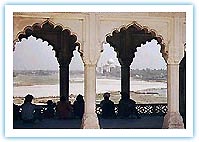



    |
 rlooked,
help complement and enhance this spectacular monument.
rlooked,
help complement and enhance this spectacular monument.
Background
Unlike other Mughal tombs, the garden of the Taj Mahal has been laid out entirely
in front of the tomb and does not play any part in the 'background'. Instead,
the background has been provided by the sky. This background is not constant;
it changes its colour and texture more than often, and the Taj is always presented
in a variety of tints and moods. Its shades are subtly reflected on the white
marble surface of the Taj Mahal which changes its colour and complexion accordingly.
Marble
The Makrana marble used is of such a nature that it takes on incredibly subtle
variations of tint and tone, according to the changes in the light, thus picturing
the passing colour of the moment.
Soaring Effect
The colossal height of the tomb, along with its pyramidal appearance (which
is obtained by the receding plinths, the square tomb and the bulbous dome,
along with the pilasters surmounted by pinnacles, the tapering minarets and
the decreasing volume of the dome culminating in a kalasa) give it a soaring
effect. It appears as if it is about to rise into the sky...an ethereal quality
full of lightness and grace.
Correction of Illusionary Effects
The indigenous builders of the Taj Mahal fully understood the deceptive nature
of the human eye. They knew that the reality and its perception and interpretation
thereof differed. The plinth of the main tomb is 2'10'' high on an average.
But the height varies at different places, particularly the central point
between two piers being in each case 0.5" to 0.7" higher than the
sides. This convexity has deliberately been given to the plinth in the centre
of each arch, or else the building would have appeared as if it were falling
down! The facades are not exactly at a right angle with the plinth, but are
slightly inclined.
The finial is a stupendous crowning feature which measures nearly 10 meters!!
The architect fully anticipated the apparent size which a finial would present
from such a great height. It has therefore been very ingeniously been planned.
These features of construction demonstrate the ability of the Indian architects
to reconcile the illusionary effects created by distance and light.
Click
here for More Details......
| Rajasthan || Kerala || Goa || Taj Mahal || Wildlife || India Hotels || India Travel Guide || Beaches || Honeymoon |
| HOME | ABOUT US | CONTACT US | RESERVATION | EMAIL |
| Copyright © All Right Reserved MIDTOWN TRAVELS PVT. LTD. |